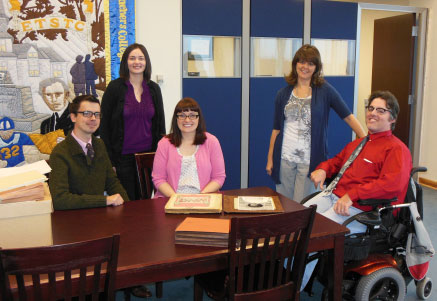
The friendly staff at the Archives of Gee Library at Texas A&M University Commerce. Those smiles are real; they love helping patrons find unique information and relics. I once found a fiddle there that Ruby Allmond of Bonham used when performing at the Greenville Municipal Auditorium.
A few weeks ago, I slipped off to Commerce to one of my very special places, the archives at Gee Library on the campus of Texas A&M University Commerce. On the fourth floor with windows on the north and west sides of the Reading Room, one can see for miles and miles and wonder what that part of the world looked like back in the early 1840s when first settlers arrived.
I have been researching in the Bowman Papers and what a treasure. L. L. Bowman came to Texas around 1900 from Mississippi and Tennessee where he received a law degree at Cumberland Law School in Lebanon, Tennessee. The young man joined the law firm of Ben F. Looney, a prominent local attorney. Bowman served as City Attorney, District Attorney, on the Greenville School Board for sixteen years, and was appointed Judge of the 8th District Court in January 1931 after practicing law here for more than thirty years.
It was while he journeyed throughout his judicial district of Hunt, Hopkins, Delta and Rains Counties that he developed a deep interest in the history of Northeast Texas. At every courthouse he visited with local citizens, with other attorneys, and with anyone who had a story to tell. However, he wanted true stories so he used his time in the various courthouses to look through probates, land records, criminal and civil cases. His notes recorded old roads throughout the counties with precise reasoning why the road went that way.
One of my favorite items in his collection is Twenty-Seven Years on the Texas Frontier, or Fifty Years in Texas by William Banta, an early settler in Hunt County. Less than a dozen copies were printed, and one is in Commerce at Gee Library Archives. It was exciting to hold it and read it.
As I dug around this past week I found notes that a grand jury in Sulphur Springs convicted Reconstruction outlaw Ben Bickerstaff. I co-authored The Devil’s Triangle: Ben Bickerstaff, Northeast Texans, and the War of Reconstruction. My co-authors and I believed that most of those individuals were never brought before a grand jury. Since we want to release a new edition, I think a drive to the Hopkins County Courthouse is in order. Thanks to Judge Bowman, I now have the volume and page numbers.
I now know that the first attempt at prohibition in the county occurred on July 15, 1854 when an election was called to abolish the sale of liquor in less than a quart. In 1858 the city of Greenville was one-half mile square around the courthouse. In the same year a Board of Executive was appointed to license teachers. Many such tidbits lie hidden in those acid free boxes.
Why am I interested, you ask? Good point. Just like an exceptional seamstress can sew colorful scraps of cloth to create a quilt, or jigsaw puzzle fanatic can put tiny pieces together to create a scene, or a composer puts notes in the right line or space to create a musical score, I want to use these ideas to create a history of very early Greenville and Hunt County History. One that will reveal the earliest settlers, their stories, and the lessons learned. Few people will know all the stories, but with the help of people like Judge Bowman I can write that book.
